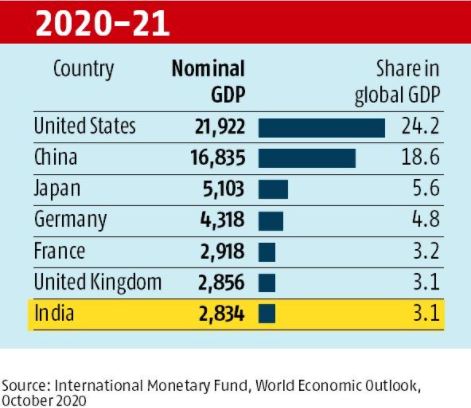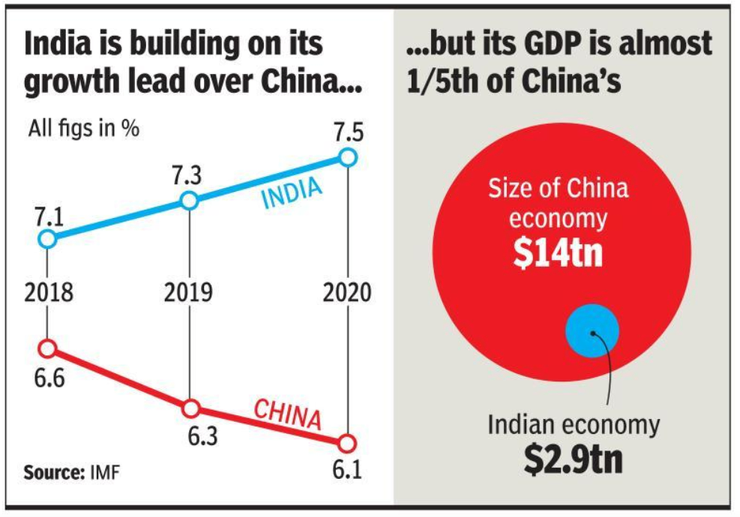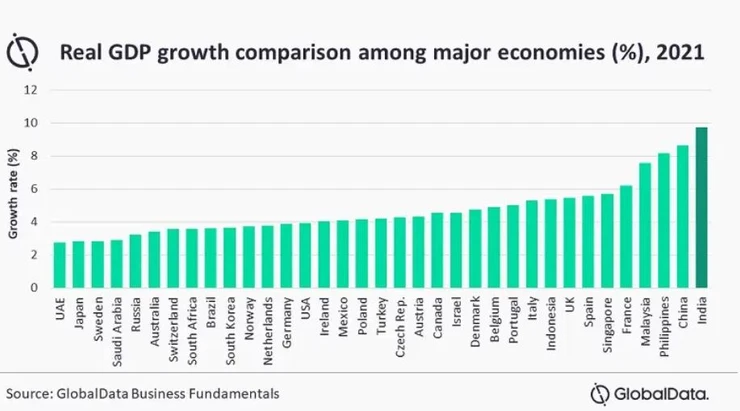Share
Why is China usually ahead of India when it comes to economic growth?
Flashback :
In the same year that India adopted its constitution, China became a communist republic country. Both China and India began rebuilding in 1950, with Mao Zedong in charge for China and Pandit Jawaharlal Nehru in charge for India.
Despite over 200 years of colonial exploitation, India had the greatest economy in Asia at the time. China was playing catch-up with the rest of the world. Mao Zedong competed with Pandit Nehru, who was regarded as a visionary with strong democratic credentials by foreign leaders.
In terms of the economy, military power, technical growth, and even pollution control, China is well ahead of India. China has advanced at an exponential rate to become a global superpower, whilst India is still considered a developing country.
In terms of the economy, military power, technical growth, and even pollution control, China is well ahead of India. China has advanced at an exponential rate to become a global superpower, whilst India is still considered a developing country.
 |
| One Belt-One Road initiative |
When Indians or Americans invest in another country, they typically do so through private companies and private funds. Governments have a limited role to play. However, Chinese investment is a bilateral agreement between governments.
China's economy is based on infrastructure, investment, and manufacturing, while India has only scratched the surface in all three areas.
China has one of the world's highest investment rates, which has fueled its growth. As a result, new cities, high-speed train lines, airports, and ports have been built, as well as manufacturing muscle that has been admired around the world. For the past two decades, China has served as the global manufacturing. Its capacity to move what it produces fast and effectively both domestically and internationally has been a major component of its growth miracle.
Large-scale private-sector investment, both from India and abroad, has fostered the rise of Indian technology. These businesses need infrastructure to succeed, but it was digital rather than physical, allowing Indian IT firms to send data and analysis from India to the rest of the world and back long before the term "cloud" was coined. They didn't need to ship widgets because their reputation was good enough.
On all three fronts, India is currently far behind China. Outside of the Western world, China has the best physical infrastructure. India appears to be the impoverished country that it is.
 |
| GDP Ranking |
A few of the reasons are why the Indian infrastructure is not as good as the Chinese are:
Corruption :
Government corruption is a huge impediment to the development of anything, be it infrastructure or small-scale enterprise. This causes problems for projects at all levels, from the most basic to the most complex. The more money involved in bribes, the larger the project. India is ranked 94th in the corruption index, whereas China is ranked 80th. However, conditions in India are improving as the public shows displeasure with corruption.
Course of Action :
The Chinese economy opened up and reforms began in 1978, but Indian economic reforms began in 1991. As a result, China has a 13-year investment advantage over India's economy.
The Sluggish Nature :
In the Indian markets, there is rampant red-tapism, and the bureaucracy, while skilled, is sluggish and misuse its authority at many levels. The present Indian government is working relentlessly to eliminate the need for unnecessary paper work, and the situation has improved noticeably as a number of initiatives have been completed.
Democracy?
Because China is not a democracy like India, the Indian government cannot do whatever it wants. Land acquisition, which is the initial step in infrastructure construction, is a time-consuming and nearly impossible task. There are frequent protests by vested interests, which are backed by politicians in order to acquire a vote bank advantage. Because of the uncertainty, multibillion-dollar projects are in jeopardy.
Lack of Team Play :
There is a lack of coordination among government bodies. The environment ministry raises an objection just as a project is nearing completion, claiming that required clearances were not obtained. It's difficult to comprehend how the construction was permitted to begin in the first place. This, together with other factors, causes project delays. Most of the time, corruption is the cause.
Need for Planning :
While certain Indian towns are planned, such as Noida, Greater Noida, Gandhinagar, Chandigarh, Navi Mumbai, and others, the majority of Indian cities remain unplanned, densely populated, and crowded. Some cities are very old and thus haphazardly built, making any form of infrastructure upgrade impossible to accomplish.
Metro Concentration :
India's traditional economic hubs are limited to a few cities, such as Delhi and NCR (National Capital Region), Mumbai, Bangalore, Kolkata, Chennai, and Hyderabad, and this is causing a huge population to migrate to these cities in pursuit of work. These cities are already overcrowded, and the infrastructure required to maintain such a big population is lacking.
This not only causes infrastructure deficits in metropolitan cities, but it also limits infrastructure growth in other small cities since funds are redirected to the upkeep of these traditional economic hubs. This can be addressed by creating new cities and economic hubs, but it will be a difficult effort.
Politics :
Regional politics play an important influence in the development of any region, and politicians tend to favour their home areas above those that are "in need" of infrastructure. Until this year, the railway budget nearly always favored a certain region over the national interest.
Some upcoming airports have been cancelled owing of political conflicts between two political parties. Because of these silly rivalries, infrastructure projects undertaken by previous governments are placed on hold by the following government, and the whole process has to be repeated. As a result of the political unrest, businesses and investments have suffered losses.
How to cope up:
According to one estimate, India's average infrastructure investment in the first 50 years after independence was 3% of GDP, despite the fact that it required more than 6.5 percent. China, on the other hand, invested nearly 9% of GDP in infrastructure when a 6.5 percent investment would have sufficed.
 |
| GDP wise Data |
The 2019 Economic Survey recommended that India invest 7-8 percent of GDP in infrastructure in order to achieve strong growth and a $5 trillion economy by 2025. According to the report, investment has been 27% lower than what is required.
 |
| India outnumbers China in Real GDP Comparison 2021 |
For India, there is a real opportunity. Increase the amount of money invested. Infrastructure should be improved. Increase the economy's output. This is a tried-and-true road to development, and India, now, appears to be on track to follow it.
The good news for India is that the private sector is willing and able to help. However, it appears that the business sector will wait until it has more confidence in politics before acting.
While India's IT industry is amazing and developing, it is evident that the country as a whole will need to develop the old-fashioned way, with improved infrastructure and more manufacturing.
India has a plethora of raw materials to deal with. The next step is to catalyze it.
Scroll.in







0Comments